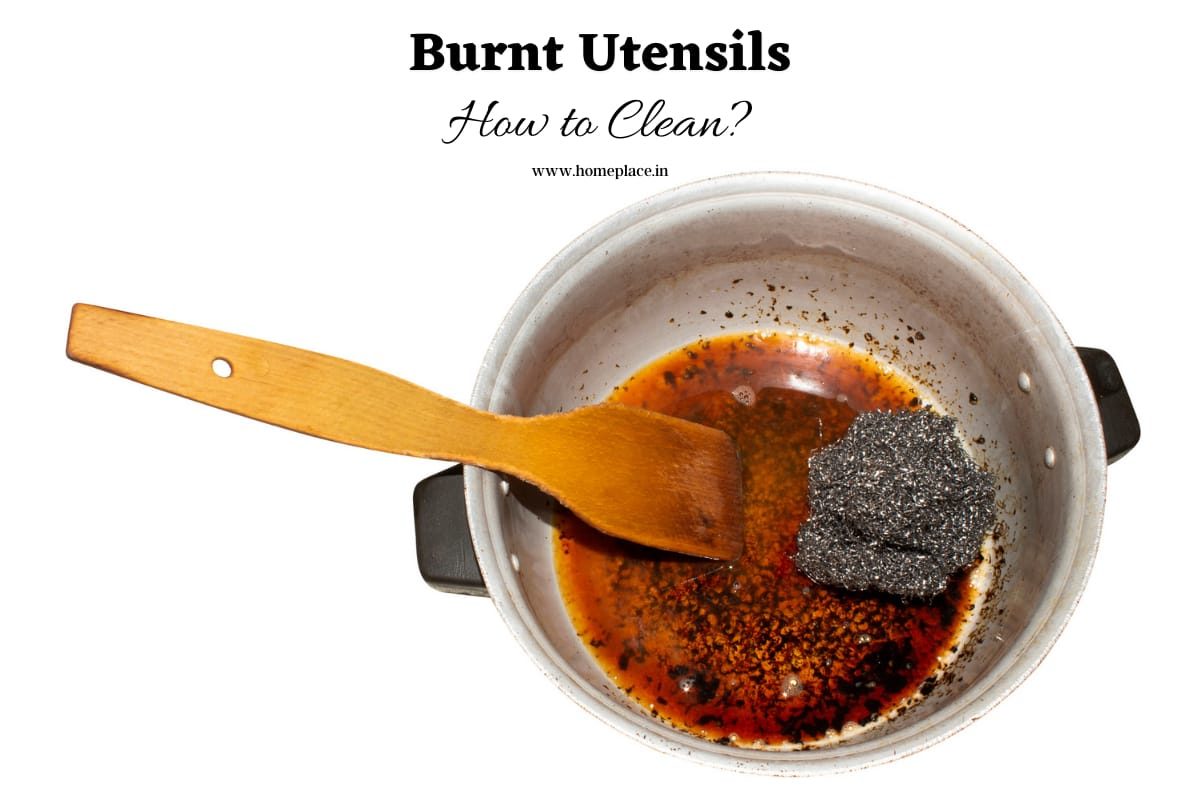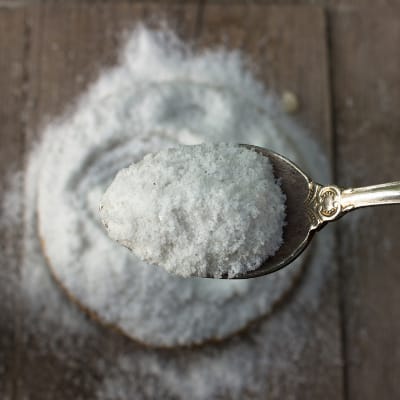Getting the best utensils for cooking is not enough. Whether you like to cook or not, burnt utensils are never a pleasant kitchen cleaning experience. Cleaning the burnt cookware is not an easy task either, that is, only if you don’t know the tricks.
Fortunately, for your convenience, we’ve listed some of the best ways to clean burnt utensils without breaking a sweat. So, let’s get started.

1. Use Baking Soda, Water, and Detergent for the best result

Starting with the most basic and readily available method to clean burnt vessels made of common cookware materials, the solution of baking soda, water, and liquid detergent can clean even the most stubborn of sticky burns on utensils. First, soak the utensil in the solution for about 10 minutes. Then simply scrub it out using a plastic or a metal scrubber.
Don’t overdo scrubbing if the marks are not getting away, or it may damage the utensil. Instead, repeat the above method, only this time add a bit of heat while soaking.
Try scrubbing the utensil again, and your vessel will most likely be suitable as new. If not, repeat the process.
2. Make use of Coca Cola to clean burnt vessels

Not only does Coca Cola provide an excellent and refreshing taste, but it also works excellent when it comes to cleaning burnt utensils. You can utilize this delicious beverage known for its soothing properties to avoid stubborn burnt patches on your frying pan.
All you need to do is simply pour some of the drink into your utensil and put it on your gas stove at low heat. Keep the vessel that way until the bubbles stop popping.
Remove the container from heat and scrub it off using a plastic scrubber and dish soap. That’s it; the trick works even better with utensils made of aluminum.
3. Apply wine to clean burnt utensils

Even though you wouldn’t want to follow this method unless necessary, wine works wonders when cleaning burnt stainless steel cookware. It softens the thick layer of burnt char on your utensils, just like vinegar.
Cleaning burnt utensils with wine is as simple as pouring some of the wine in your vessel and allowing it to stay that way for a few minutes. Then, you can just scrub the stains out using a plastic scrubber.
4. Use vinegar and baking soda to remove dark patches

While you can use vinegar or baking alone for this purpose, the combination of vinegar and baking soda works even better. The reason is vinegar has acidic properties while baking soda has abrasive properties. The variety of both works like a charm to remove even the most stubborn thick burnt patches from your cast iron cookware.
Start the cleaning by boiling vinegar and water in your burnt utensil to soften the thick layer of burnt patches.
Let it cool for a while, dump out the liquid, and add baking soda to it. Now, gently scrub the vessel with a plastic scrubber while adding more baking soda to remove even the toughest stains.
5. Apply Alka-Seltzer Tablets on the burnt utensil

The Alka-seltzer tablets work wonders for cleaning burnt utensils, thanks to the citric acid present in Alka-seltzer tablets. Just fill your vessel with water and put it on low heat.
Meanwhile, depending upon the size of the utensil and the amount of burnt char, add 5-10 Alka-seltzer tablets and let them fizz for 1 hour. The citric acid will soften the stains, allowing an easy cleaning by using hot water, a liquid dishwasher, and a robust scrubber.
6. Use Tomato Ketchup on Burnt Aluminium Utensils

Cleaning your burnt utensil using ketchup is one of the easiest and readily available hacks you can apply. However, the method does take a significant amount of time. Cover the stains on your tawa with a thick layer of tomato ketchup and let it sit overnight.
The acidic properties of tomato ketchup will do the magic and remove the burnt char from the utensil by morning. Then, after all the burnt char has softened, wash your tawa using a liquid dishwasher and a plastic scrubber in the morning.
7. Get Onions for Cleaning burnt stains
The magic of onion in cleaning stubborn burnt stains is something you can’t ignore. Onion is a multi-purpose vegetable used in various cooking recipes and to remove burnt stains.

To utilize onion as a cleaner for burnt stains on non-stick cookware:
- Fill the burnt vessel with water (partially) and drop 5-6 onion skins, depending upon the number of burnt stains and size of the vessel.
- Cover the vessel with a lid and boil it for about 20-30 minutes on high heat settings.
- Empty the vessel and wash it with water and dishwasher liquid.
Using onions is an eco-friendly way of cleaning burnt utensils as this method does not involve any harsh chemicals that can harm the environment. You can also check various eco-friendly cleaning tips to apply to your home and kitchen.
8. Apply Common Salt in boiling water

The cheapest way to clean burnt utensils is by using salt. All you need to do is scrub your burnt vessel hard with a good dose of salt on your scrub pad.
However, we recommend boiling water with a good amount of salt in the burnt vessel before scrubbing for more effective results. Also, unlike other methods, salt will give a decent shine to your utensils, as if the burnt stains were never there.
9. Use Cream of Tartar to clean burnt utensils

Cream of Tartar works the similarly as common salt; even the cleaning method follows the same steps. Add about two tablespoons of salt to the burnt vessel filled with water.
Bring the water to a boil and let it stay that way for about 20 minutes. After that, clean the utensil with the usual cleaning methods, i.e., water and dishwasher soap or liquid.
10. Get Dryer Sheets to Clean Tough Burnt Marks

Soaking a dryer sheet in a burnt utensil filled with warm water can eradicate some of the toughest burnt stains. Soak a dryer sheet in your burnt vessel and wait a few hours.
Make sure to push the dryer sheet underwater to get it fully saturated. Wipe the vessel or cutlery items using a fabric softener when the burnt stain softens. However, you might be allergic to the chemicals used in the dryer sheets. Make sure to take all safety measures while using this method.
11. Make Use of Aluminum Foils

This is the most straightforward method to remove burnt stains from cookware. Although not suitable and reliable if the stains are thick and stubborn, this method works wonders sometimes.
All you need is aluminum foil and a bit of warm water to compliment it. Just crumple up some aluminum foil and scrub the ball of aluminum foil on tough burnt stains to remove them. Add salt or cream of tartar to increase the efficiency of this method.
12. Apply Lemon Juice to Burnt Aluminium Utensils

Lemon juice contains acidic properties that are ideal for cleaning, no wonder most dishwasher soaps and liquids contain lime as an ingredient. Eradicating burnt stains from grill pans using lemon juice is child’s play.
All you have to do is apply a decent dose of lemon juice to the stains on the burnt utensils and leave it for a while. Let the acid contained in the lemon juice do the trick. After a few hours, you’ll see that the stubborn burnt stains are not so stubborn anymore.
Now, you can easily scrub them off your cookware using warm water(preferred) and dishwasher liquid.
Read: How to Clean Stainless Steel Cookware?
Frequently Asked Questions
The easiest way to clean a burnt vessel, in our opinion, is using baking soda and water. Simply put the soda on the burnt area and add water. Leave the cookware for 10 minutes and then use a non-abrasive scrubber to remove all the burnt patches.
Multiple ways allow you to clean a badly burnt saucepan easily. We recommend this method by doing it with a solution of baking soda and vinegar. Vinegar is an acid, while baking soda is abrasive; the combination of both will remove even the toughest of burnt stains while giving a sparkling shine to your saucepan as if the stains were never there. First, dilute the vinegar with equal amounts of water and pour the solution into the pan. Heat the badly burnt saucepan until the liquid comes to a boil. Let it boil for one minute and carefully remove the solution from the pan. Let the saucepan cool down and scrub it gently with a plastic scrubber with added baking soda to eradicate the burnt stains.
You have to be extra careful while dealing with non-stick utensils, as using the wrong ingredients can ruin the non-stick coating of your utensils. To clean burnt non-stick utensils, avoid using abrasive ingredients like baking soda and use acidic ingredients instead. Our best bet is doing it by using Coca-Cola or wine. Pour some Coca-Cola into your burnt non-stick vessel and put it on a stove at low flame. Let the bubbles pop and remove the utensil from the stove as soon as the gentle fizzing stops. Finally, gently scrub your non-stick utensil using a plastic scrubber and dishwasher liquid.
You can naturally remove the discoloration of aluminum pans by cooking acidic food such as tomatoes in the pan. Boiling a vinegar and water solution in the pan can do the trick in minutes. Just make sure to scrub the pan with a soap-filled scouring pad afterward.
Removing stains from a Kadai is a piece of cake as it requires nothing but aluminum foil with a dishwasher detergent. Pour warm water in the Kadai and add a few drops of liquid dishwasher detergent into the water. Mix the solution thoroughly using a spoon and sit for a while. After that, crumble a piece of aluminum foil in the shape of a ball. Start scrubbing the Kadai with the ball of crumpled aluminum to get rid of all the stubborn stains quickly and in an instant.

Burnt utensils can ruin your cooking experience in an instant; that’s a fact. At the same time, cleaning burnt utensils isn’t as hard as you may think either. Various methods can easily clean your burnt utensils like a charm. We’ve covered multiple processes in the 12 best ways of cleaning burnt utensils; you can choose the ones that suit you the best.
